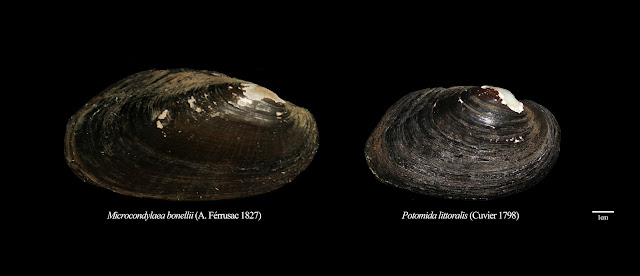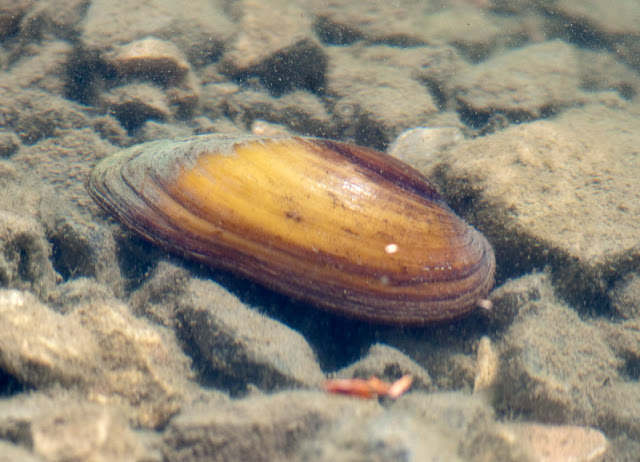Μύδια του Γλυκού Νερού!
Νέο επιστημονικό άρθρο δίνει την πρώτη ολοκληρωμένη εικόνα της κατάστασης των πληθυσμών στην Ευρώπη
Ένα από τα πιο γοητευτικά στοιχεία της βιωτής των ποταμών και λιμνών είναι τα μύδια του γλυκού νερού - ποικιλόμορφες αχιβάδες που επιτελούν σημαντικές οικολογικές υπηρεσίες. Τα μύδια αυτά είναι σαν "ζωντανά φίλτρα" για το νερό - ένα μύδι μπορεί να φιλτράρει έως και 40 λίτρα νερού την ημέρα. Τα μύδια έχουν και μια ιδιαίτερη σχέση με τα ψάρια - ως λάρβες ζουν πάνω στα ψάρια και έτσι μεταναστεύουν μαζί τους. Τα μύδια δημιουργούν και ειδικούς βιοτόπους στον πυθμένα των ποταμών - εκεί ζουν πολλά και διάφορα άλλα είδη ζωής, ένα ψάρι μάλιστα γεννά τα αυγά του μέσα στα μύδια. Πολλά είδη μυδιών του γλυκού νερού είναι εξαιρετικά μακρόβια - ζουν περισσότερο από 100 χρονιά!
Όμως πόσοι από εμάς έχουν την παραμικρή ιδέα ότι πρόκειται για πολύ σημαντικά πλάσματα του γλυκού νερού που βρίσκονται στο χείλος της εξαφάνισης σε πολλές περιοχές της Ευρώπης;
Μία νέα δημοσίευση στην επιστημονική επιθεώρηση "Biological Reviews" (I.F. 9.67) έδειξε ότι στην Ευρώπη έχουν καταγραφεί συνολικά 16 είδη. Δυστυχώς υπάρχουν σοβαρά χάσματα γνώσης και προβλήματα επιβίωσης για πολλά από αυτά τα είδη. Συνεργάστηκαν 49 ερευνητές από 26 χώρες και διάφορους ακαδημαϊκούς οργανισμούς για να ολοκληρωθεί αυτή η έρευνα. Η χώρα μας είναι από τις πιο άγνωστες σε σχέση με την καταγραφή των ειδών αυτών- δεν έχουμε καλή γνώση της χωρικής κατανομής ή της κατάστασης διατήρησης τους. Κάποιοι πληθυσμοί έχουν εξαφανιστεί από περιοχές στις οποίες είχαν γίνει καταγραφές δεκαετίες πριν. Κάποιοι πληθυσμοί διαφέρουν τόσο που υποψιαζόμαστε ότι είναι νέα είδη για την επιστήμη!
Η ερευνητική επισκόπηση διοργανώθηκε άπo Πορτογαλική και Γερμανική ομάδα και υπήρξε μεγάλη προσπάθεια ανασκόπησης της βιβλιογραφίας σε αρχεία και μουσεία σε όλη την Ευρώπη - και στην χώρα μας. Στην Ελλάδα, σημαντική βοήθεια προσέφερε το Ζωολογικό Μουσείο Αθηνών (βοήθησε ο Αναστάσιος Λεγάκις) του Πανεπιστημίου Αθηνών (ΕΚΠΑ) και ο Τομέας Εσωτερικών Υδάτων του Ινστιτούτου Θαλάσσιων Βιολογικών Πόρων και Εσωτερικών Υδάτων του ΕΛΚΕΘΕ. Από το ΕΛΚΕΘΕ, ο Σταμάτης Ζόγκαρης και ο Ιωάννης Καραούζας συνεχίζουν την έρευνα των δίθυρων με τους κύριους ερευνητές του άρθρου στα Βαλκάνια. Υπάρχει πολύ καλή συνεργασία με τους Πορτογάλους ειδικούς Δρ. Manuel Lopes-Lima και Δρ. Ronaldo Sousa και έρευνα πεδίου στην Ελλάδα σχεδιάζεται να διεξαχθεί και το 2016.
Για ερευνητικές εργασίες πεδίου στην Ελλάδα το 2014 δείτε εδώ:
Για περισσότερες πληροφορίες κατεβάστε το επιστημονικό άρθρο εδώ:
Γενική Ανασκόπιση για τα μύδια του γλυκού νερού στην Ευρώπη:
Γενική Ανασκόπιση για τα μύδια του γλυκού νερού στην Ευρώπη:
---------------------------------------------------------------------------------------------------------------
First study on freshwater
mussel stocks in 26 European countries
The Status Quo on Europe’s Mussels
Mussels
are the natural treatment plants of bodies of water and, therefore, just as important
as bees. Unfortunately, they are equally threatened: most of the world’s mussel
stocks are in decline and some species face extinction. For this reason,
scientists from 26 European countries have compiled the first comprehensive
survey on the status quo of freshwater mussel species in Europe and can now
provide recommendations for the future protection of the species.
It may not always be
obvious due to their concealed way of life, but mussels are among the most
endangered species in the world. These mussels have an interesting life cycle
since they have a parasitic stage on fish, where mussel larvae attach and
metamorphose into juveniles. Very little was known about
the status quo of mussel fauna up to now, as there was no information available
on the stock sizes of this underwater organism. The varying surveying methods
used by different countries exacerbated the problem. A catalogue of the 16
freshwater mussel species found throughout Europe is now be published for the
first time in the journal “Biological Reviews”. The project was coordinated by
researchers the Interdisciplinary Centre of Marine and Environmental Research
(CIIMAR) in Portugal and the Technical University of Munich (TUM).
A
pivotal role bodies of water
The survey’s three main
authors, Manuel Lopes-Lima and Ronaldo Sousa from CIIMAR and Professor Jürgen
Geist from TUM, describe how crucial mussels are for aquatic ecosystems: they
form around 90 percent of the biomass in the bed of a water body. In addition,
mussels filter the water and have a major influence on the water quality as a
result. “Because a single mussel filters up to 40 liters of water per day,”
report the authors, “we humans also benefit from the ecosystem services
provided by mussels.” When the hard-shelled animals keep a body of water clean,
more invertebrate organisms tend to join them there. Due to their crucial role
in the aquatic habitat, the extinction of these small natural treatment plants
in rivers and lakes would have serious impacts on the aquatic habitat.
Catalogue
of characteristics
So what do the freshwater
mussels, some of which live for over a century, need to survive? The research
network, comprising scientists from 26 countries, collected information about
the requirements of European mussels vis-à-vis their habitat and began by
answering the following questions:
·
Where do which species arise?
·
How big is the current stock?
·
How are the species related to each other?
·
What are their preferred habitats?
·
What are the greatest threats to their survival?
One result of the
Europe-wide study is the extent of the gap between north and south. There are
fewer species in the north of Europe, for example Scandinavia, but the
populations there are bigger. In contrast, southern Europe has more species,
but some of them are only found in a handful of waters. This can be due to the
fact that they are specialized on one fish species and if this species only
arises on the Iberian Peninsula, the mussels that depend on it can only survive
in proximity to it. In addition, mountain ranges like the Alps and Pyrenees act
as geographical barriers. “If a mussel population dies out in just one location
in the south, this can represent half of the global population,” as explained
by these scientists.
Which habitats do the
mussels prefer?
The fact that some mussel
species are dispersed all across Europe and have given rise to different
strains could be related to the ice ages and periods between them, on the one
hand, their fish hosts and the conquest of new habitats, on the
other. In addition, the scientists established that less demanding mussel species
can spread more successfully, as they can survive in different water bodies and
quickly adapt to changes in the water quality. Similarly, some
species prefer warmer, stiller waters while other mussel strains are more
tolerant and can survive just as well in cold rivers and streams as in lakes.
What
are the threats to Europe’s mussels?
The authors also
summarize the main threats to the species in their report:
·
Barrages, weirs and dams
·
Pearl fishing (for certain species)
·
Pollution and over-fertilization
·
Loss of fish hosts
·
Invasive species
· Water extraction and climate change
· Other hitherto unknown stress factors
To ensure the long-term
conservation of freshwater mussels for aquatic ecosystems and their functions,
the authors recommend that detailed scientific plans with defined objectives be
compiled. Targeted protection should be provided for populations that are
important from an evolutionary perspective and whose stocks have already been
reduced by 90 percent, water bodies with a high level of mussel species
diversity, and also healthy mussel stocks in intact habitats. “Because a mussel
is highly dependent on its fish host and these are in decline, particular
attention should be paid to the fish stocks,” as explained by the authors,
“even if some of these fish species do not have any particular economic value.”
In Greece, the Zoological Museum of Athens University spearheaded by Anastasios Legakis and the Department of Inland Waters of IMBRIW at HCMR worked on this paper. Stamatis Zogaris and Ioannis Karaouzas from HCMR continue work with the main authors of the review paper for research into the Balkan fauna. Field surveys are being planned in Greece for 2016.
For a look at field survey work in Greece see this:
For further information please download the review paper in proof form here:
Review Paper:
Freshwater Mussels in EuropeReview Paper:
Reoport on the rare genus Potamida in Mediterranean inland waters:
 |
| Freshwater mussel species illustrated in the recent "Biological Reviews" paper. |
 |
| Freshwater mussel species illustrated in the recent "Biological Reviews" paper. |
 |
| Pearl mussel species illustrated in the recent "Biological Reviews" paper. |
 |
| Lake Yliki is a very important habitat for freshwater mussels near Athens. Λίμνη Υλίκη, Βοιωτία - πολύ σημαντικός βιότοπος για τα μύδια του γλυκού νερού κοντά στην Αθήνα. |
 |
| A mussel species found in an artificial lake on Mount Parnitha near Athens. Είδος μυδιού του γλυκού νερού σε τεχνητή λίμνη στην Πάρνηθα (Φωτό: Δ. Κουτσογιαννόπουλος). |
